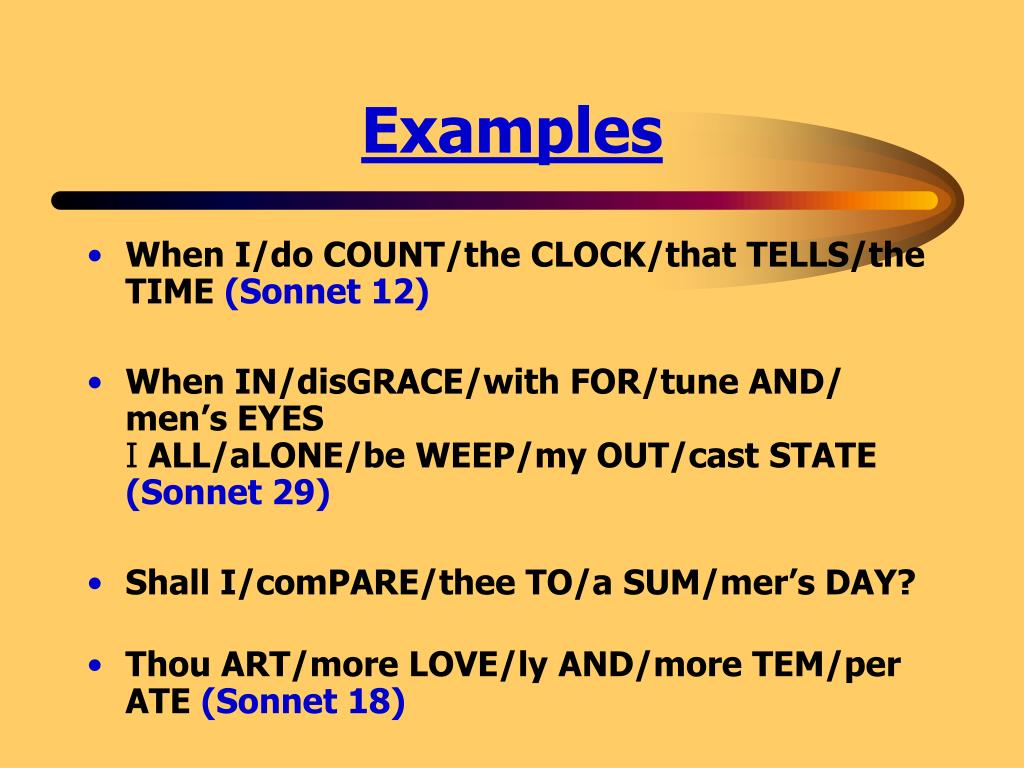


English or Shakespearean Sonnet: Named for William Shakespeare and a variation of Italian sonnet, this sonnet pattern consists of three four-line Quatrains and a concluding couplet with the rhyme scheme ABAB CDCD EFEF GG.Italian or Petrarchan Sonnet: Named for the Italian Renaissance lyrical poet Francesco Petrarch, this sonnet pattern consists of an eight-line Octave with the rhyme scheme ABBA ABBA, followed by a six-line Sestet that follows one of two rhyme schemes, CDE CDE or CDC CDC.Slovenian poet France Prešeren is best remembered for his Wreath of Sonnets, an example of a crown of sonnets.In English literature, there are two basic sonnet patterns: In such a sequence, the last line of the first sonnet repeats as the first line of the second one, and sometimes these lines make up another sonnet. Sonnets can be linked together into a crown of sonnets. Another pattern is Spenserian sonnet, invented by Edmund Spenser. It was used in the poem Meeting at night. The scheme abba abba cde edc is very rarely, but its ending sequence cde edc was probably the source for Robert Browning's stanza abccba. However, the rhymes of the sestet in an Italian sonnet can vary widely: cdcdcd, cddcdd, etc. Is the typical pattern of an "English" sonnet. The letters of the alphabet are used to show the pattern of rhyme, or "rhyme scheme," in the 14 lines in a sonnet. In the traditional " Italian" or "Petrarchan" sonnet, the poem divides into a group of eight lines ("octave") followed by a group of six lines ("sestet"). The last two lines usually rhyme, and make up a "rhymed couplet" that concludes the poem by summing up the story told in the previous quatrains. In a traditional " English" or "Shakespearean" sonnet, the first twelve lines are divided into three groups (" stanzas") of four lines each, called "quatrains". Modern poets have often changed the traditional rhythms and rhyme patterns of the sonnet, sometimes radically. Vincent Millay was one modern poet writing in English who often worked in the sonnet form. The rigid rhyme scheme of the sonnet went out of fashion during the twentieth century, but a few modern poets still write them sometimes. In United States Henry Wadsworth Longfellow and Emma Lazarus wrote sonnets.Įmma Lazarus, the poet who wrote The New Colossus Later English poets like John Donne, John Milton, William Wordsworth, Percy Bysshe Shelley, and John Keats wrote sonnets that are still admired and studied today. William Shakespeare wrote the most famous sonnets in English literature, though other poets of his time, such as Ben Jonson, Edmund Spenser, Michael Drayton, and Samuel Daniel, wrote sonnet sequences also. Poets in other countries quickly adopted the sonnet and sonnet sequence. Michelangelo, a famous sculptor and painter wrote sonnets, too.


It became common for poets to write sonnets in connected series, called "sonnet sequences," to tell a story, often one about a love affair. Even in distant Poland sonnets were written by Jan Kochanowski, Mikołaj Sęp Szarzyński and Sebastian Grabowiecki. So did Thomas Wyatt and Henry Howard, Earl of Surrey in England. Francisco de Sá de Miranda, the poet who brought sonnet from Italy to Portugal


 0 kommentar(er)
0 kommentar(er)
